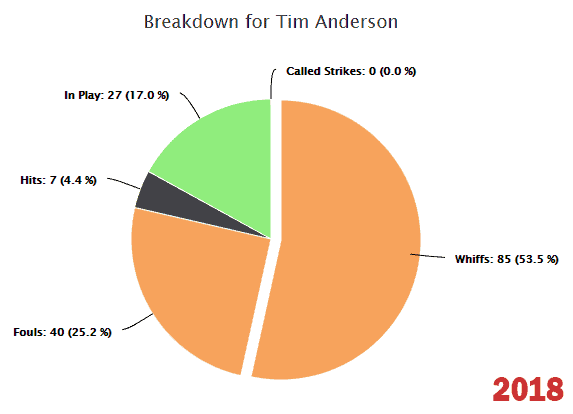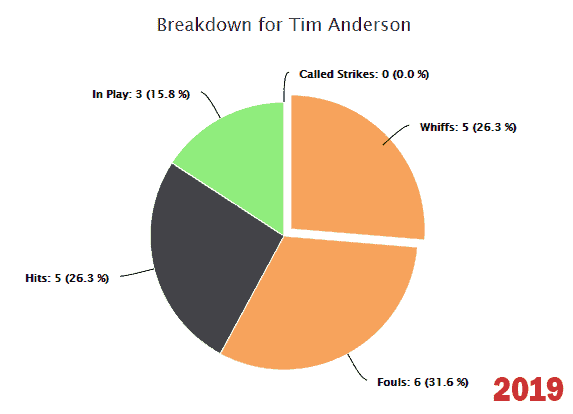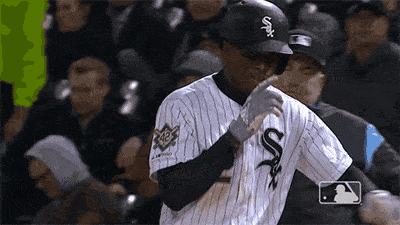A couple of days ago, I poked at the numbers running underneath Yoan Moncada and Carlos Rodon's starts under the headline "Watchable White Sox trends that don't involve Eloy Jimenez."
In the comments, Mike pointed out that I hadn't mentioned perhaps the most watchable White Sox of them all -- the .444-hitting Tim Anderson.
The problem with Anderson is that there isn't a new trend under anything he's doing, analytically. He still has a very large strike zone, he's still extremely aggressive, and so he's still striking out 10 times for every walk. At the time I wrote that piece, Anderson's hitting streak had halted, so it looked like I'd be writing about a Tim Anderson that would fail to exist in a matter of days.
Then he hit a grand slam on Sunday and went 3-for-4 with a double on Monday, so this crazy BABIP-addict profile is still very much alive.
Anderson has always required an elevated amount of faith. He was a recent convert to baseball when the White Sox drafted him, so everybody had to believe the athlete could be whittled into a baseball player. While he advanced up the ladder, you had to believe his hyper-aggressive approach wouldn't be easily exploitable, and that he could stick at shortstop.
Entering his third full season, he had established himself as a glove-first shortstop with 20-20 ability, but a plate approach that undermined the rate stats that signify value. Even the most ardent believers know walks aren't part of the reward, so the only way he could close this gap was by being a better Tim Anderson.
It's not out of the question. We just saw Avisail Garcia makie it to an All-Star Game by being the best possible Avisail Garcia. That Garcia stayed healthy and found a way to slash his strikeout rate by more than 5 percent, but the other key components of his success -- infield singles and opposite-field power -- remained his calling cards.
Anderson's kinda going about it a similar way. With the caveat that it's early, Anderson is carrying an 18.5 percent strikeout over his first 54 plate appearances, which is a rather remarkable drop from the 26-percent rate he carried into the season. He's doing this despite 1) seeing more slow/breaking stuff, and 2) swinging at more pitches outside of the zone. His plate discipline numbers at FanGraphs:
| 2018 | Category | 2019 |
| 52.4 | Fastball% | 45.8 |
| 40.3 | O-swing% | 40.0 |
| 58.3 | O-contact% | 63.6 |
That last line is the most notable difference in his profile. He's chasing just as much as he usually does, but he's not swinging over as many pitches, and the ones he's putting into play are coming off the bat a little bit harder.
Staying back on breaking balls was an area of focus over the offseason. During spring training, James Fegan relayed a quote from Todd Steverson:
“Take a look at everybody on an off-speed pitch, there’s a little period of silence in there before their heads actually go,” White Sox hitting coach Todd Steverson said. “(Anderson) doesn’t want to just get loaded, get the foot down, swing. Then you’re out front of all of them and you don’t really recognize it. He wants to be in a position to recognize it so he can make that pause, and make the determination and then go ahead and throw hands at it.”
Baseball Savant now offers video of every single pitch, and so you can see how Anderson has offered at every breaking pitch. For instance, here's a slashed single through the right side off Tampa Bay's Ryne Stanek on April 9. Neat!
Anderson showed the ability to do it last year, but only fleetingly. There are two Gameday zones for low and away -- Nos. 9 and 14 -- and Baseball Savant allows one to find all secondary pitches that Anderson saw in those zones. He had only seven hits on low-and-away breaking balls from right-handed pitchers last year. This year's, he's already at five.
His success with his swings at pitches in those areas is drastically different thus far. Here's last year's breakdown of what happened when he offered at offspeed and breaking pitches low and away:

And here's this year's:

I suppose we'll soon see whether this gets incorporated into scouting reports over the next few weeks. One possible advantage is that Anderson will make pitchers go against the grain of leaguewide trends, where pitchers are throwing their fastballs less often than they've ever thrown them before. If Anderson starts seeing fewer breaking pitches to attempt to counter his growth, it shouldn't be dramatically so.
Of course, this could all be just a hot fortnight of good balance and better results, and maybe it erodes as the length of the season sets in. Moncada's improvement feels more sound because he's simply doing more with the pitches he should be able to do the most with. Anderson, at least for the time being, is conquering the pitches that have always given him hell. Maybe they'll eventually bite back, but Anderson is starting his season by backing up his talk, in particular this line:





